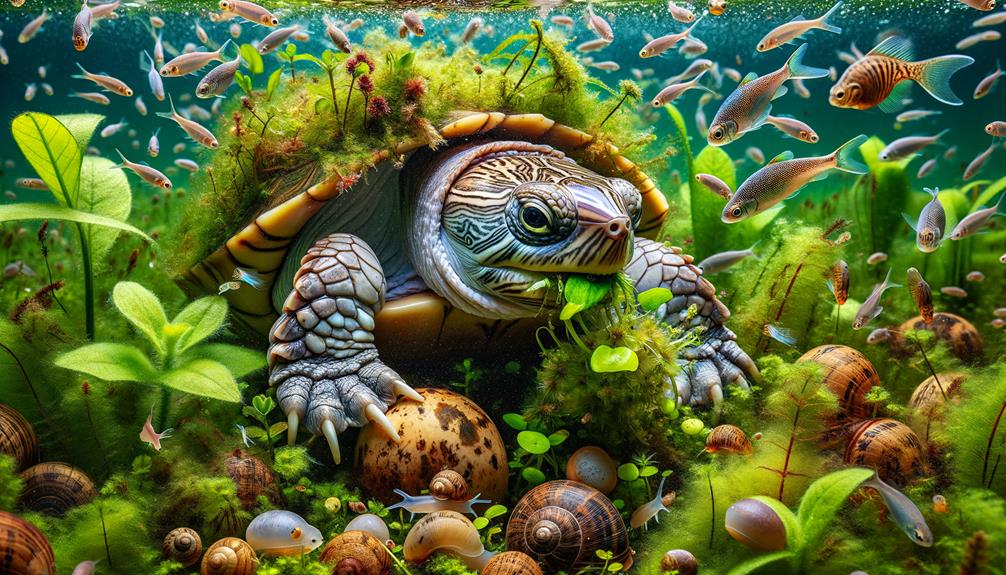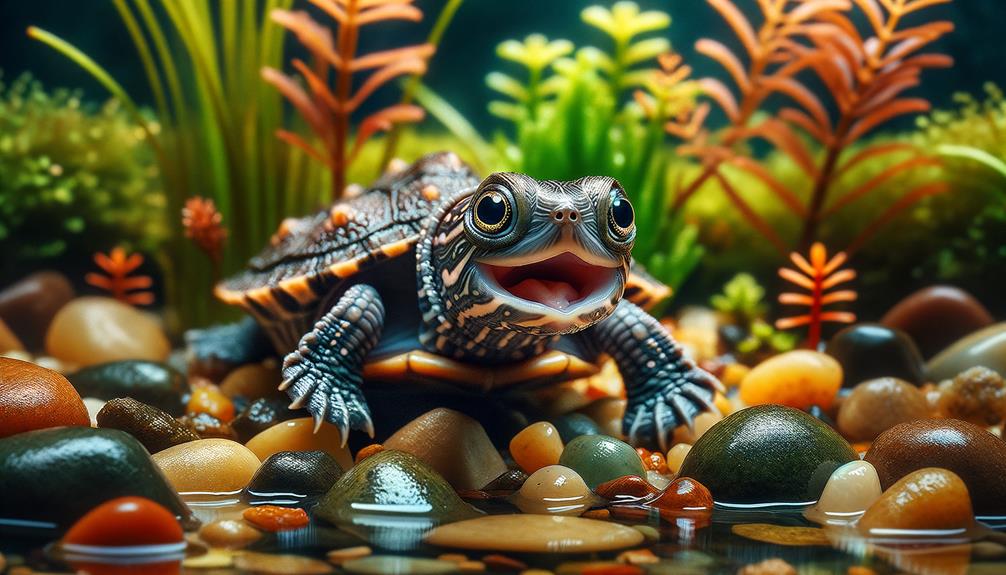I find musk turtles utterly captivating. These small reptiles, with carapaces only 3-5 inches long, showcase an olive-brown to gray hue often topped by green algae. When threatened, they release a foul odor – a testament to their feisty nature. Thriving in shallow, slow-moving waters, they feast on a diverse diet of insects, snails, and minnows. Their curious nature leads to lively underwater explorations. Males can be territorial, adding an extra layer of complexity to their behavior. With their unique traits, there's still much to uncover about these intriguing creatures!
Key Takeaways
Musk turtles are small, typically measuring between 3-5 inches in carapace length. When threatened, they release a foul-smelling odor, showcasing their feisty nature. Known for their lively and curious behavior, musk turtles are active explorers. Males can be territorial, adding to their confrontational demeanor. They thrive in shallow, slow-moving waters with sandy or gravelly bottoms, where they can be found actively exploring their surroundings.
Characteristics of Musk Turtles
One of the most striking features of musk turtles is their small size, with an average carapace length of just 3-5 inches. These tiny aquatic turtles, also known as Sternotherus odoratus, pack a lot of personality into their small frames. Their olive-brown to gray carapace, often covered in green algae, helps them blend in seamlessly with their muddy habitats.
What really sets them apart, though, is their feisty temperament. Despite their small size, these turtles aren't afraid to stand up for themselves. When threatened, they release a strong, foul-smelling odor from their scent glands, earning them the nickname "stinkpot." This natural defense mechanism helps them ward off predators and stay safe.
Musk turtles are also skilled swimmers, but they prefer to spend their time walking along the bottoms of lakes and slow-moving rivers. Their diet is just as varied as their habitats; they feed on aquatic insects, worms, snails, clams, minnows, tadpoles, and even aquatic plants. These traits make Sternotherus odoratus a fascinating species, combining toughness and adaptability in a way that's hard not to admire.
Habitat and Environment

Musk turtles thrive in shallow, slow-moving waters with sandy, gravelly, or cobble bottoms. In these tranquil aquatic havens, they've found their perfect sanctuary. The eastern musk turtle, in particular, calls the southern half of Michigan's Lower Peninsula home, where they roam freely in their natural habitat.
These turtles prefer a small home range, typically spanning just 2-4 acres of aquatic habitat. This limited area ensures they have everything they need within a compact space. Their carapace, or upper shell, helps them blend seamlessly into their surroundings, providing both camouflage and protection.
In April or May, mating rituals take place underwater, a fascinating spectacle for those lucky enough to witness it. By June, females lay 3-5 eggs in shallow soil or beneath organic debris, safeguarding the next generation's safe start. After 2-3 months, tiny hatchlings, less than an inch in length, emerge ready to explore their watery world.
Understanding these feisty creatures and their aquatic retreats is deeply liberating, reminding us of the delicate balance in nature's design.
Diet and Feeding

Musk turtles are known for their hearty appetites and diverse tastes. In the wild, they feast on a variety of aquatic insects, worms, snails, clams, minnows, and tadpoles. This carnivorous diet is crucial for maintaining their overall health and energy levels. While they're not picky eaters and will consume almost anything that moves in their aquatic environment, they may occasionally nibble on some aquatic plants, although plants don't make up a significant portion of their diet.
To ensure they thrive, providing a varied diet is crucial. A balanced meal for these turtles should include:
- Commercial turtle pellets as a convenient staple to meet their basic nutritional needs
- High-protein items like worms, crickets, and small fish to keep their diet robust
- Aquatic insects and crustaceans to add diversity and mimic their natural feeding habits
- Occasional plant matter to round out their diet without overdoing it
It's essential to avoid overfeeding, as musk turtles can become messy and their health might suffer from too much food. A varied and balanced diet guarantees they stay happy and healthy in their aquatic habitats.
Behavior and Temperament

Known for their lively personalities, musk turtles showcase fascinating and sometimes feisty behavior that captivates enthusiasts and casual observers alike. Despite their small size of just 3 to 5 inches, they pack a lot of character into their tiny frames. One of the most intriguing aspects of their behavior is their response when threatened. Unlike many other creatures, they don't shy away quietly; instead, they release a strong, foul-smelling odor. This musky scent, from which they get their name, is a bold defense mechanism that underscores their spirited nature.
Musk turtles are also known for their active and curious nature. They're often seen exploring their aquatic environments with a sense of determination and vigor. These turtles exhibit a feistiness not just in their defensive tactics but in their daily activities, making them endlessly entertaining to watch. Males, identifiable by their longer tails with visible spikes, can sometimes be more territorial, adding another layer of dynamic interaction within their habitat. Their spirited and sometimes confrontational behavior makes musk turtles a unique and exciting species to observe, embodying a sense of independence and liveliness that resonates with anyone who values self-reliance and energy.
Conservation and Management

Efforts to conserve musk turtles are crucial as we face increasing habitat loss and degradation, mainly due to human activities. These fascinating creatures are struggling to survive as their aquatic environments are threatened. But there's hope! Through dedicated conservation efforts, we can ensure that these small, feisty turtles continue to thrive.
Our approach involves several key strategies:
Habitat Preservation: We're working to protect and restore wetland habitats, which are essential for the turtles' survival.
Captive Breeding Programs: We're reinforcing populations through controlled breeding and head-starting initiatives to give the turtles a fighting chance.
Public Awareness: We're raising awareness about the vital role musk turtles play in aquatic ecosystems, which is crucial for their survival.
Research Initiatives: We're studying their behavior, ecology, and life history to inform better management strategies and ensure their long-term survival.
I'm passionate about musk turtles and believe that with the right actions, we can make a difference. Habitat loss doesn't have to mean the end for these resilient creatures. By supporting captive breeding programs, we're giving them a second chance. Public education is vital, as the more people know, the more they'll care. Together, we can protect these vital members of our aquatic ecosystems and ensure their future for generations to come.
Frequently Asked Questions
How Do I Know if My Musk Turtle Is Happy?
I've noticed that happy musk turtles love to explore their surroundings. I keep an eye out for signs like active swimming, a healthy appetite, clear eyes, and smooth skin. When they bask frequently and show no aggression, I know they're doing well.
Why Are My Musk Turtles Fighting?
My musk turtles are fighting because they're establishing dominance or competing for resources. Since they need space to thrive, overcrowding can trigger aggression. To reduce their territorial battles, I'll provide more space, hiding spots, and resources. By doing so, I'll create a more harmonious environment for my musk turtles to live in.
What Is the Common Musk Turtle Behavior?
Understanding musk turtle behavior is fascinating! These solitary creatures have a feisty reputation, and when threatened, they release a foul odor. Their diet consists mainly of aquatic insects and fish. Despite their small size, musk turtles can live a long life, providing endless entertainment in your tank.
Are Musk Turtles Friendly?
Are musk turtles friendly? From my experience, they're not typically friendly. They're feisty and defensive, often trying to bite or release a foul-smelling musk when handled. With patience and consistency, they may become more docile, but it's rare.



